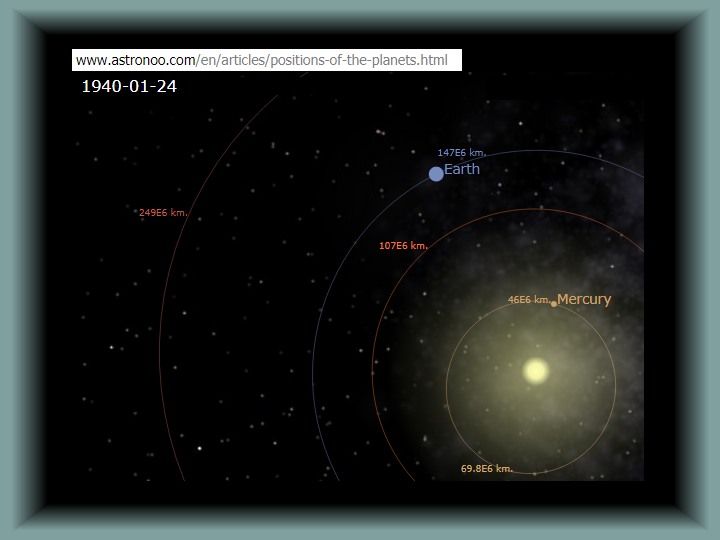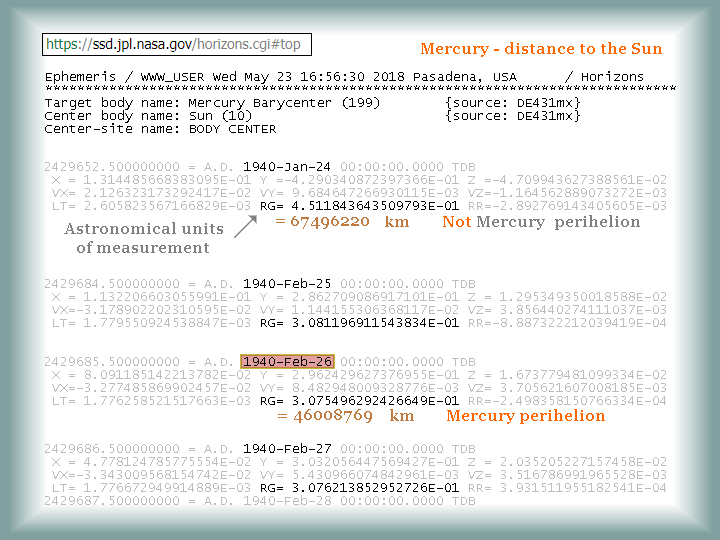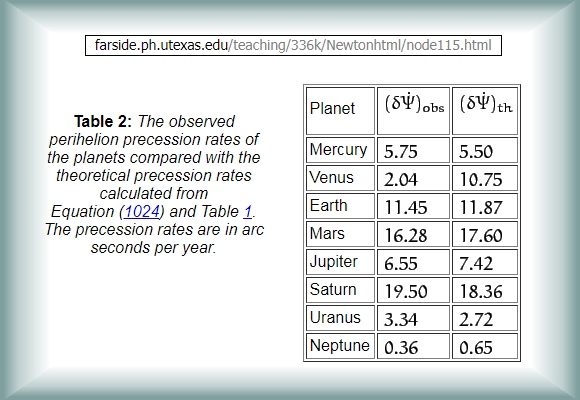I
have considered the Horizon
Ephemeris data (above) as my primary data
source of positional information due to it offering
numerical 3D data. But as this comparison
shows, it would be a tragedy to take any one source as infallible.
Most other websites only offer blunt averages (without even
saying which orbits the average represents) and don't give
differing distances for perihelion/aphelion for different
years. These two websites are the only ones I could find that
go back to 1940 at all.
Nevertheless, despite what I take to be an error by Astronoo.com
they have still been a good source of positioning for the
other planets in purely observed 2D angular
terms of perihelion and aphelion. Most especially astronoo.com
are one of the few to get Neptune's perihelion seemingly correct,
which almost everyone else outside of Horizon Ephemeris has
seemingly in the wrong position by 45 full
degrees (more on that later). The Horizon Ephemeris
also contradicts itself more than once, so multiple analytical
cross-referencing is an imperative part of worthwhile methodology
as we shall see.
But if anything this just goes to show how much information
typically just gets reproduced without analytical assessment
as to how correct it is in terms of simple logical consistency.
(Never mind the observational inconsistencies and theoretical
conjecture). Perihelion does move from year to year but not
by the amounts exposed above; which is clearly a gross mistake
by somebody.
In our method of logical-positivism
we assume nothing, and try to prove and re-examine
everything that we possibly can. Its not just a matter of
quoting the 'experts' and having faith in their fame, but
checking everything for logical consistency, that can be checked.
And to do this you do not actually need much more than an
entry level PC, some medium-level programming software, and
an acute sense of deliberation.
When looking at the data required just to start evolving this
algorithm, and the variations on offer, I had suspected that
my results for Perihelion Precession would not be in keeping
with the crudeness of the numerical models from previous centuries.
Just trying to find consensus on the gravitational constant,
shows that one does not have to move more than a few decimal
places to find inaccuracy and disagreement.
The missing amount in Perihelion Precession (mentioned in
the Introduction)
that has been attributed to Einstein's theories is immensely
dissonant. As as already been noted in the previous chapters,
if we apply Einstein's limit at the velocity of light to Mercury,
then we must get a loss in velocity when compared
to the Newtonian model. A loss in velocity must
cause an inwards spiral to an orbit.
This will amount to about 2km per year that
Mercury would spiral inwards due to Einstein's limit
at the velocity of light. It is quite interesting that for
100 years it seems that nobody else has noticed
that losing velocity away from the Newtonian calculations
must decay the orbit. The only possible 'compensation' for
this could be if gravity is delayed due to it traveling at
the velocity of light (from General Relativity). This will
undoubtedly cause an outwards spiral to any orbit
depending on the comparative masses of the two objects. (See
the phenomenon BOGVOS
from previous chapters).
But BOGVOS (gravity-delay) will result in a 40m
outwards spiral per orbit for Mercury. This is not nearly
enough to compensate for the 2km inwards
spiral caused by for the loss in velocity as Mercury approaches
light-speed. Worse than this: A gravity-delay will cause an
outwards spiral for the Alpha Centauri binary star-system
of well over a million km per orbit. And, for the
Moon's orbit around the Earth, an outwards spiral of 400m
per orbit will result from such a delay in gravity. Both of
these are wholly unacceptable.
It was for these reasons; a lack of logical constancy in the
Nobel prize-winning Relativistic paradigm, that this very
analysis was undertaken. The Relativists have sure got a lot
of compensating to do! Dogmatic assertion of that which is
contrary to logic is not part of any viable methodology.
Moreover note again the observational data table from utexas.edu:




